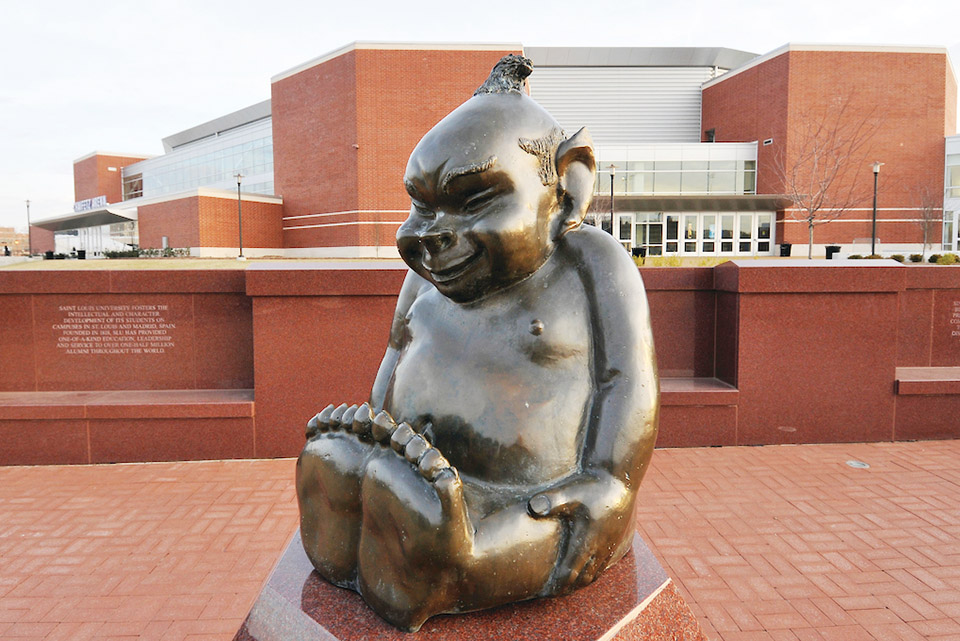1904 was a banner year for the city of St. Louis and for Saint Louis University. The World’s Fair drew 12 million visitors to Forest Park, many of whom marveled at the University’s elaborate booth in the Palace of Education, which was awarded eight medals for its exhibits. Bold numerals over the entrance gate announced Saint Louis University’s foundation date-1829-and the University published a volume in 1904 to commemorate its diamond jubilee. 1829? Diamond jubilee? What about the 1818 foundation date on Saint Louis University’s seal, logo and every official publication and press release?
Yes, a little school called The St. Louis Academy, which never had more than a handful of teachers and students, was founded by Bishop Louis Du Bourg next to the cathedral in 1818. Ever since the Jesuits first came to Missouri in 1823, Bishop Du Bourg and his successor, Bishop Joseph Rosati, C.M., had begged them to take over the faltering academy, but it closed at the end of the 1826-27 school year. Hence, Fr. Charles Van Quickenborne, S.J., superior of the Missouri Mission, wrote on Sept. 1, 1828, to his provincial in Maryland that St. Louis did not have a single Catholic school. The following day, Sept. 2, Van Quickenborne published a notice in the local newspaper, the Missouri Republican, announcing his intention “to open a COLLEGE in this City,” repeating the promise of “opening soon a College in this city” in the same newspaper on Sept. 23, 1828.
By Oct. 27, 1829, Van Quickenborne could report in the Missouri Republican that a building had been erected for “the intended literary institute” at Ninth and Washington and described the curriculum, regulations and fees for the new school. November 2, 1829, the day Van Quickenborne’s St. Louis College welcomed its first students, marked the real beginning of Saint Louis University. The current version of the University’s history claims that the Jesuits “assumed – direction” of Du Bourg’s academy in 1828, but how could they have “assumed – direction” of a school that had ceased to exist? And why did Van Quickenborne’s 1828 and 1829 notices make no mention of the now defunct St. Louis Academy but instead announced the “opening” of a new school?
Both the actual founders of Saint Louis University and everyone else accepted the 1829 foundation date without question until the early 20th century. Thus, in 1879, the University celebrated its golden jubilee, as recorded in Fr. Walter H. Hill, S.J.’s Historical Sketch of the St. Louis University: The Celebration of its Fiftieth Anniversary or Golden Jubilee on June 24, 1979. All of the “early missionaries” Fr. Hill interviewed took the 1829 foundation date for granted, as did the University president in 1879, Fr. Joseph E. Keller, S.J., who wrote to Pope Leo XIII on the occasion of the golden jubilee, “notum facit hunc annum quinquagesium esse a fundata universitate” (notes that this is the 50th year since the founding of the University). How could Frs. Hill and Keller and those still alive in 1879 who remembered the foundation be wrong?
Shortly after the diamond jubilee celebration of 1904, the dubious 1818 foundation date began to be used in place of 1829 so Saint Louis University’s “sesquicentennial” was marked by appropriate pomp and circumstance in 1968, and I’ll bet that preparations already are underway for the “bicentennial” in 2018. But the historical record clearly supports 1829, not 1818. Since, to quote from the official mission statement, “[t]he mission of Saint Louis University is the pursuit of truth,” we should live up to this claim by correcting a patently false foundation date.
Daniel L. Schlafly, Jr. is a professor of history at Saint Louis University








